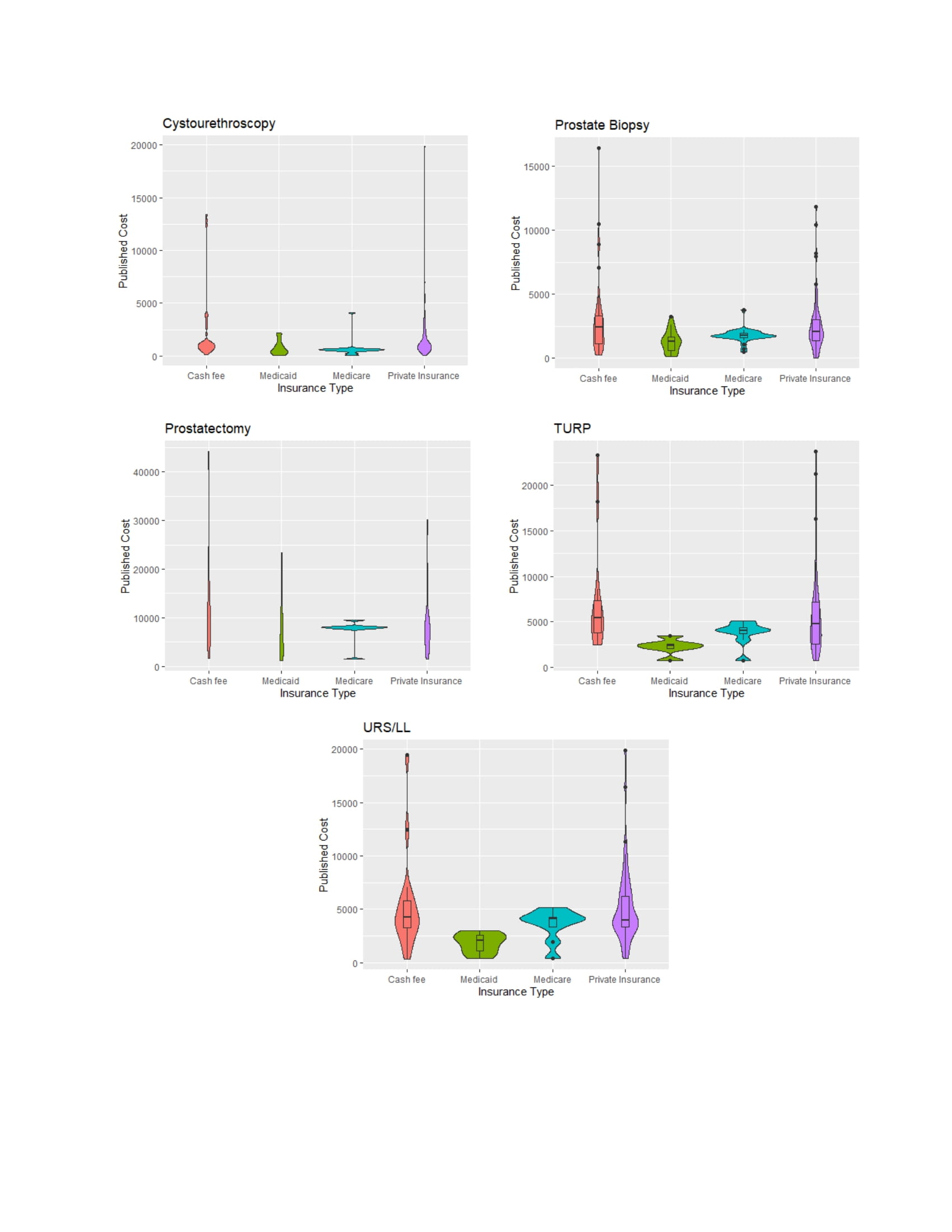Back
Poster, Podium & Video Sessions
Moderated Poster
MP28: Health Services Research: Practice Patterns, Quality of Life and Shared Decision Making III
MP28-13: Large Variations in Insurance Charges and Cash Fees for Common Urological Procedures
Saturday, May 14, 2022
1:00 PM – 2:15 PM
Location: Room 228
Cailey Guercio*, Danielle Sharbaugh, Daniel Pelzman, Emily Hacker, Levi Bowers, Ifunanya Anyaeche, Ashti Shah, Michael Stencel, Bruce Jacobs, Benjamin Davies, Pittsburgh, PA
- DP
Daniel Pelzman, MD
UPMC
Poster Presenter(s)
Introduction: The federal government required hospitals to publish negotiated prices with insurers and cash prices for all services effective January 1, 2021. Compliance has been reportedly low (5.6%). We aimed to identify compliance to the mandate and variations in negotiated prices between insurers for common urological procedures.
Methods: Using institutional data, we identified the most common urological procedures performed in 2020 and 2021, which were cystourethroscopy, prostate biopsy, laparoscopic prostatectomy, transurethral resection of the prostate (TURP), and ureteroscopy with laser lithotripsy (URS/LL). We queried the Turquoise Health Database using relevant CPT codes to identify cash fees and insurance charges for hospitals with accredited urological residency programs. We identified charges for Medicare, Medicaid, and each of the major private health insurances (Aetna, Blue Cross Blue Shield, Cigna, and United Healthcare). Using a Kruskal-Wallis test, we compared charges across each of the insurance types. Violin plots were used to demonstrate the variation between charges.
Results: Of the 161 residency-associated hospitals we investigated, only 59 (37%) had prices listed for at least one of the procedures. Wide variation exists for all investigated procedures, except radical prostatectomy. When prices were compared between Medicare, Medicaid, cash fees, and private health insurance, there was a statistically significant difference among the median price for cystourethroscopy (p-value < 0.001), prostate biopsy (p-value 0.008), TURP (p-value 0.019), and URS/LL (p-value 0.004). The median price for prostatectomy across insurances was not statistically significant, although a wide variation was apparent (Figure 1).
Conclusions: Price transparency compliance is higher than previously found, though still remains low in academic hospitals (37%). Wide variation exists between cash fees and hospital insurance charges for common urological procedures. Large variation in cost can have severe downstream effects on deductibles and contribute to the burdensome cost of healthcare for many underinsured and uninsured patients.
Source of Funding: Shadyside Hospital Foundation

Methods: Using institutional data, we identified the most common urological procedures performed in 2020 and 2021, which were cystourethroscopy, prostate biopsy, laparoscopic prostatectomy, transurethral resection of the prostate (TURP), and ureteroscopy with laser lithotripsy (URS/LL). We queried the Turquoise Health Database using relevant CPT codes to identify cash fees and insurance charges for hospitals with accredited urological residency programs. We identified charges for Medicare, Medicaid, and each of the major private health insurances (Aetna, Blue Cross Blue Shield, Cigna, and United Healthcare). Using a Kruskal-Wallis test, we compared charges across each of the insurance types. Violin plots were used to demonstrate the variation between charges.
Results: Of the 161 residency-associated hospitals we investigated, only 59 (37%) had prices listed for at least one of the procedures. Wide variation exists for all investigated procedures, except radical prostatectomy. When prices were compared between Medicare, Medicaid, cash fees, and private health insurance, there was a statistically significant difference among the median price for cystourethroscopy (p-value < 0.001), prostate biopsy (p-value 0.008), TURP (p-value 0.019), and URS/LL (p-value 0.004). The median price for prostatectomy across insurances was not statistically significant, although a wide variation was apparent (Figure 1).
Conclusions: Price transparency compliance is higher than previously found, though still remains low in academic hospitals (37%). Wide variation exists between cash fees and hospital insurance charges for common urological procedures. Large variation in cost can have severe downstream effects on deductibles and contribute to the burdensome cost of healthcare for many underinsured and uninsured patients.
Source of Funding: Shadyside Hospital Foundation


.jpg)
.jpg)